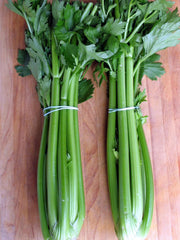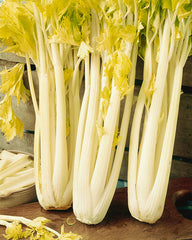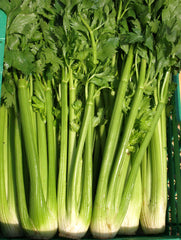Giant Red
Apium graveolens
HOW TO GROW CELERY
Start indoors 10–12 weeks before last frost, plant out 1 week after frost. For fall harvest, transplant 3 weeks before first frost, without additional protection. In a hoophouse, you can plant 2-3 weeks later. Bolting is caused by 10 days below 55˚F, when hardening off for transplant, reduce water 7-10 days. Do not harden off celery by lowering temperatures. Can handle heat and consistent moisture but prefers cool temps between 60-70˚F. Requires fertility for best crop. Garden harvest by cutting outside stalks as needed. For market remove outward growing stems and leaves, cut entire plant just below ground. Seeds require light to germinate, press into soil, do not cover. Soil pH 6.1-7.0. Hardiness zones 7. Biennial.
Days from maturity calculated from the date of seeding. Average 56,000 seeds per ounce. Federal germination standard: 55%. Usual seed life: 8 years. Isolation distance for seed saving: 3 miles.
Planting Depth surface requires light
Soil Temp. Germ. 60-75˚F
Days to Germ. 14-21
Plant Spacing 8”
Row Spacing 24–36”
Days To Maturity 100–140
Full Sun, Moist Well Drained
Days from maturity calculated from the date of seeding. Average 56,000 seeds per ounce. Federal germination standard: 55%. Usual seed life: 8 years. Isolation distance for seed saving: 3 miles.
Planting Depth surface requires light
Soil Temp. Germ. 60-75˚F
Days to Germ. 14-21
Plant Spacing 8”
Row Spacing 24–36”
Days To Maturity 100–140
Full Sun, Moist Well Drained
- 250 Seeds$3.50
- 2500 Seeds$18.00
Giant Red is a reliable trench variety which is a traditional performer and well worth growing. It is very hardy and has a purple tinge to the stalks which turn pink when blanched. It has an excellent, good old fashioned flavor. Slightly open habit but will hold until well after the winter solstice. Tags: Color: Bi-...
Giant Red is a reliable trench variety which is a traditional performer and well worth growing. It is very hardy and has a purple tinge to the stalks which turn pink when blanched. It has an excellent, good old fashioned flavor. Slightly open habit but will hold until well after the winter solstice. Tags: Color: Bi-Colored, Specialty: Storage, Heritage: Heirloom, Season: Spring Fall, Certification: Organic.
Learn More
Meet Your Farmer
We promote fair trade, organic practices and environmental responsibility throughout the Restoration Seeds supply chain. Below are the family farmers and seed suppliers who bring our open pollinated seeds to you.
Saltwater Seeds
Certified Organic by WA Dept. of Ag.
Seed grower since


We are focused on growing open-pollinated seeds adapted for the Maritime Northwest. We are inspired by the endless combinations of colors, textures, flavors, and shapes of the plants we work with.As a small, diversified business, we are committed to contributing to our small-scale agricultural economy by finding, selecting, and stewarding varieties that are productive, delicious, beautiful, and well adapted to our climate.
Reviews








